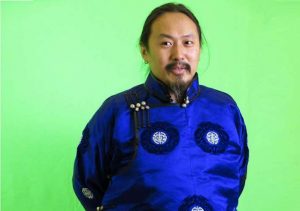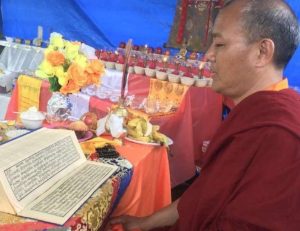
Nuns from seven nunneries participating in the annual Jang Gonchoe—the Great Winter Debate—gathered at Theckchen Chöling temple complex in Dharamsala on Saturday to make a debate presentation before His Holiness the Dalai Lama. This year’s Jang Gonchoe is being hosted by Geden Choeling, the oldest Tibetan nunnery in Dharamsala, northern India.
Prior to the Cultural Revolution in China, monks in Tibet had for centuries held an annual month-long debating session called Jang Gonchoe as an integral part of their Buddhist practice and an essential aspect of monastic education. The Tibetan community in exile re-established the practice in India, although nuns have only recently been afforded the opportunity to participate.
Representing Geden Choeling, Dolma Ling, Jangchub Choeling, Jamyang Choeling, and the Spiti Nuns’ Institute in India, and Kopan Nunnery and Thukjey Choeling in Nepal, the nuns engaged in the debates in groups of seven. One group stood and energetically challenged another seated group, who then responded, on topics as diverse as the existence of past and future lives and how effects prove the existence of a cause.
The Dalai Lama noted that there were nuns who had almost completed their study of Buddhist philosophy and would next year undergo final examinations to qualify as Geshemas —holders of what is equivalent to a doctorate in Buddhist philosophy. Taking four years to complete, the annual Geshema examination has been held only since 2013—until 2011, the Geshe title was awarded only to monks. Requiring about 18 years of study, the degree is the highest form of training in the Gelugpa school of Tibetan Buddhism.

The Dalai Lama observed that although Buddhism is practiced throughout Tibet, most people followed what had become customary on the basis of blind faith. “This is the 21st century and we need to understand the Buddha’s teachings in the light of reason. When we teach, we need to do so on the basis of reason,” he said. “I’ve met followers of the Pali tradition, monks from Thailand who are scrupulous in their observance of Vinaya. I asked them whether they explain the Four Noble Truths according to reason or citing scriptural authority. They answered that they rely on the authority of scripture.”
His Holiness continued: “All Buddhist schools of thought teach selflessness to some degree. For example it is explained in the Abhidharma, but the explanation is not very precise. On the other hand, the explanations found in the Madhyamaka texts following Nagarjuna [c. 150–250] are very thorough and clear. Buddhist scholars in India such as Dharmakirti [c. 7th century] and Shantarakshita [725–88] faced challenges from non-Buddhist scholars. The result was that their knowledge deepened and enriched.”
At the end of the proceedings, the Dalai Lama advised those present to visualize the Buddha before them surrounded by the masters of Nalanda. He then led a short ceremony to stimulate the awakening mind based on the four-line verse for taking Refuge in the Three Jewels. “Since we have Buddha nature we can achieve the Dharma Jewel within ourselves and so become a Sangha Jewel. And if we can help others, we should do so,” His Holiness concluded. (The Office of His Holiness the Dalai Lama)
See more
Nuns Participating in Annual Jang Gonchoe Debate Session Make a Presentation before His Holiness the Dalai Lama (The Office of His Holiness the Dalai Lama)
Winter Debate for Nuns (Dalai Lama Trust)
Tibetan Buddhist nuns debate at the 21st Inter-Nunnery Debate event, the Jang Gonchoe, Oct 2015(YouTube)
Tibetan Nuns to Attain Geshema Degree (BDG)












